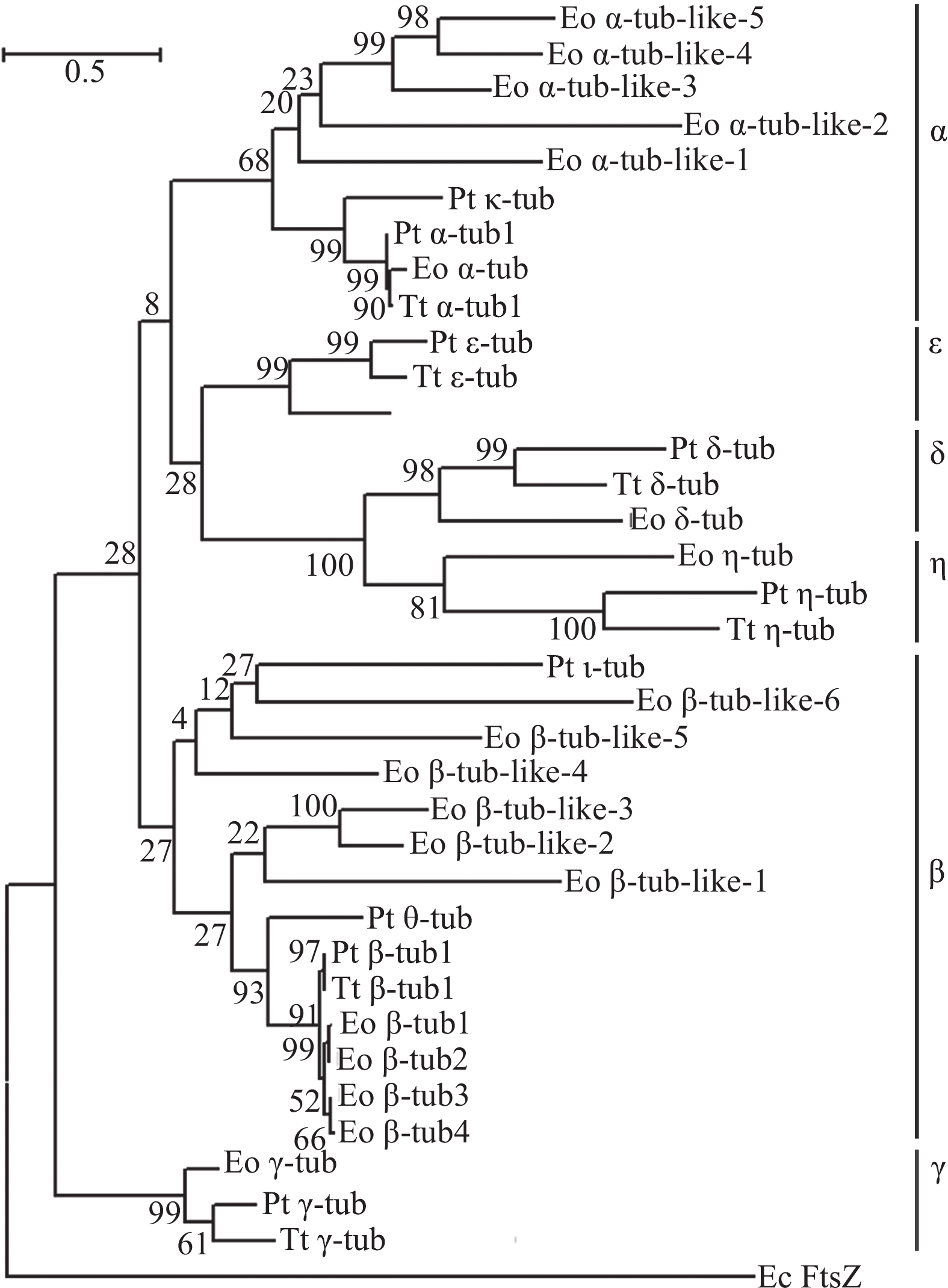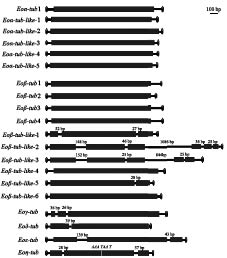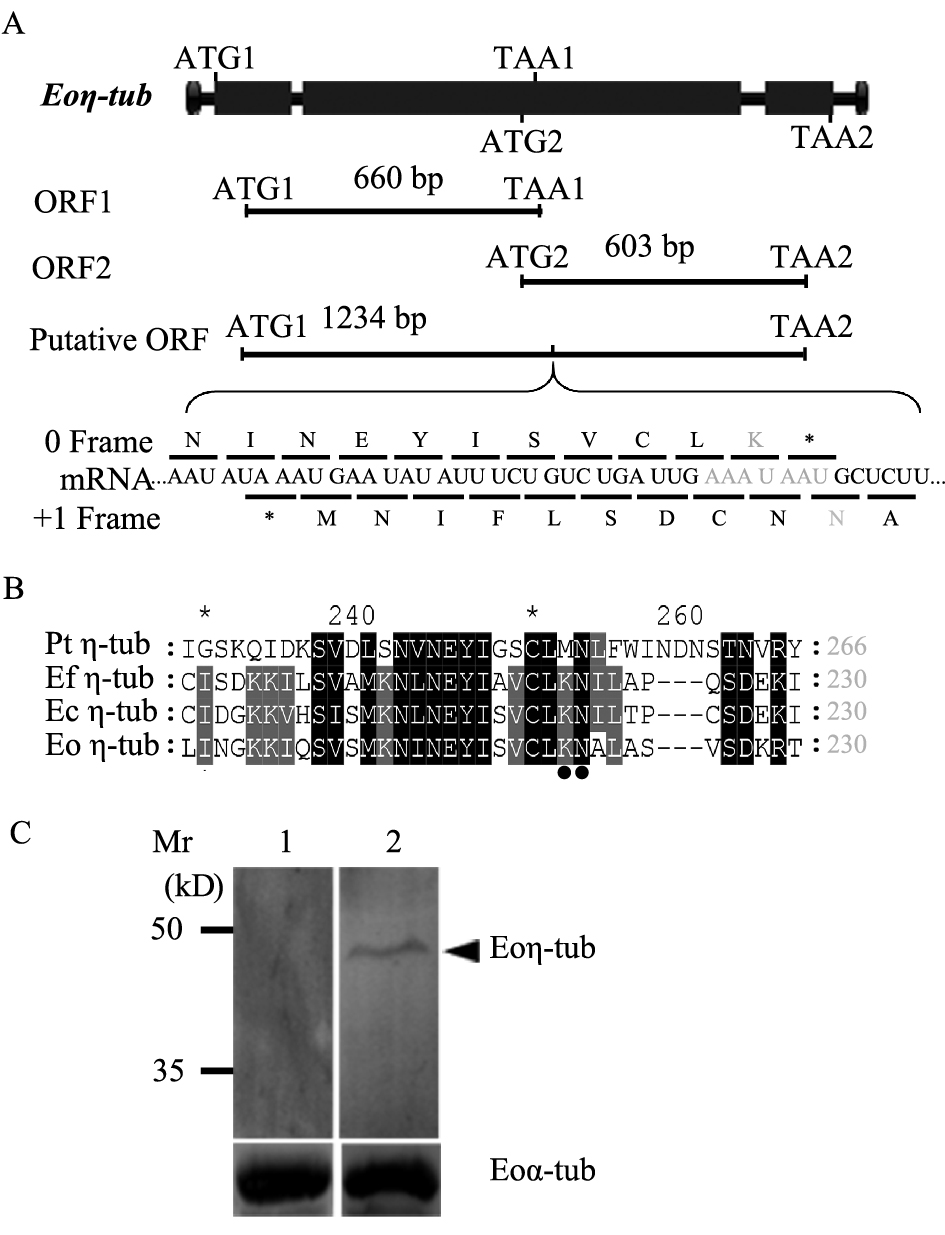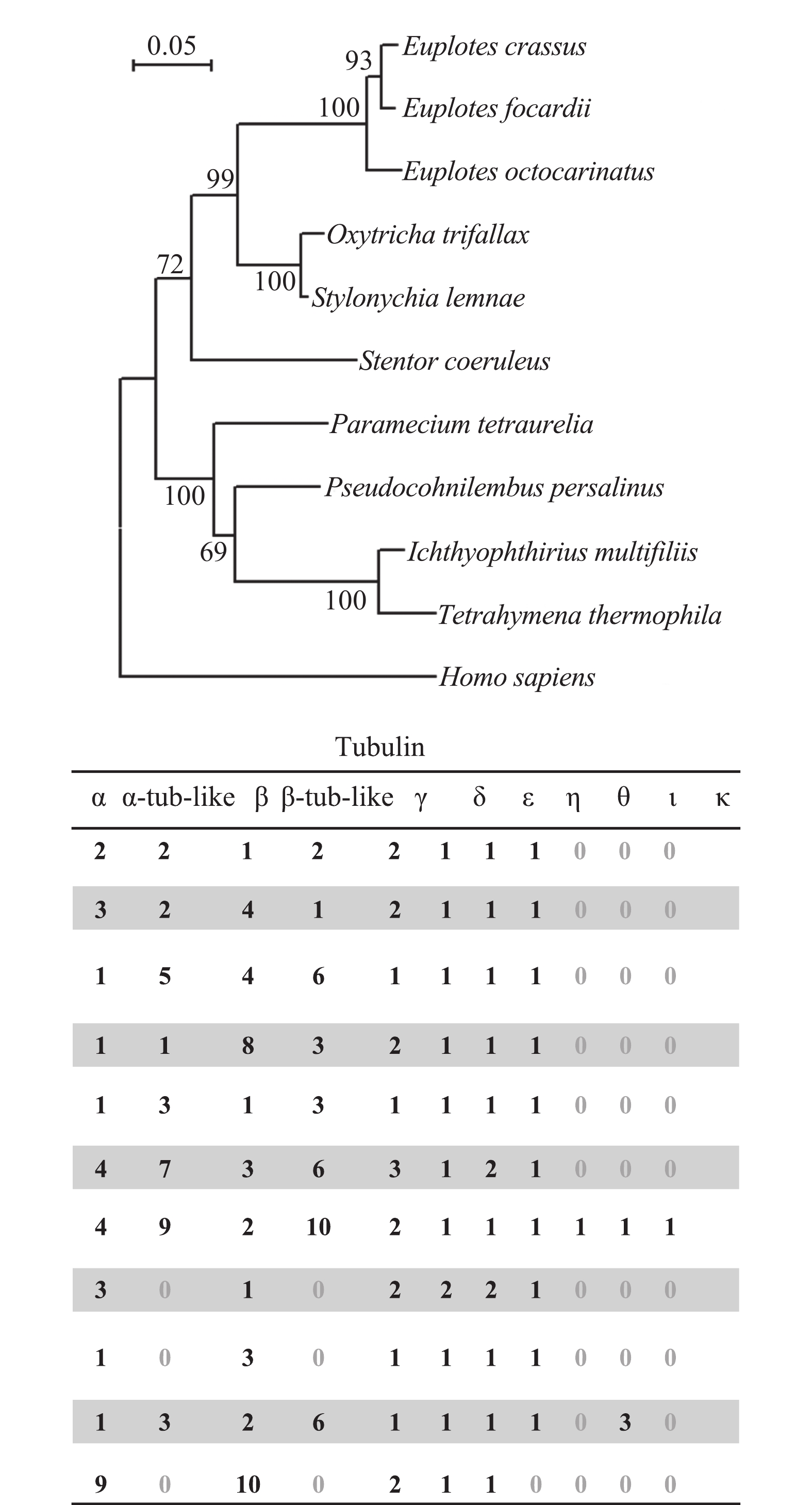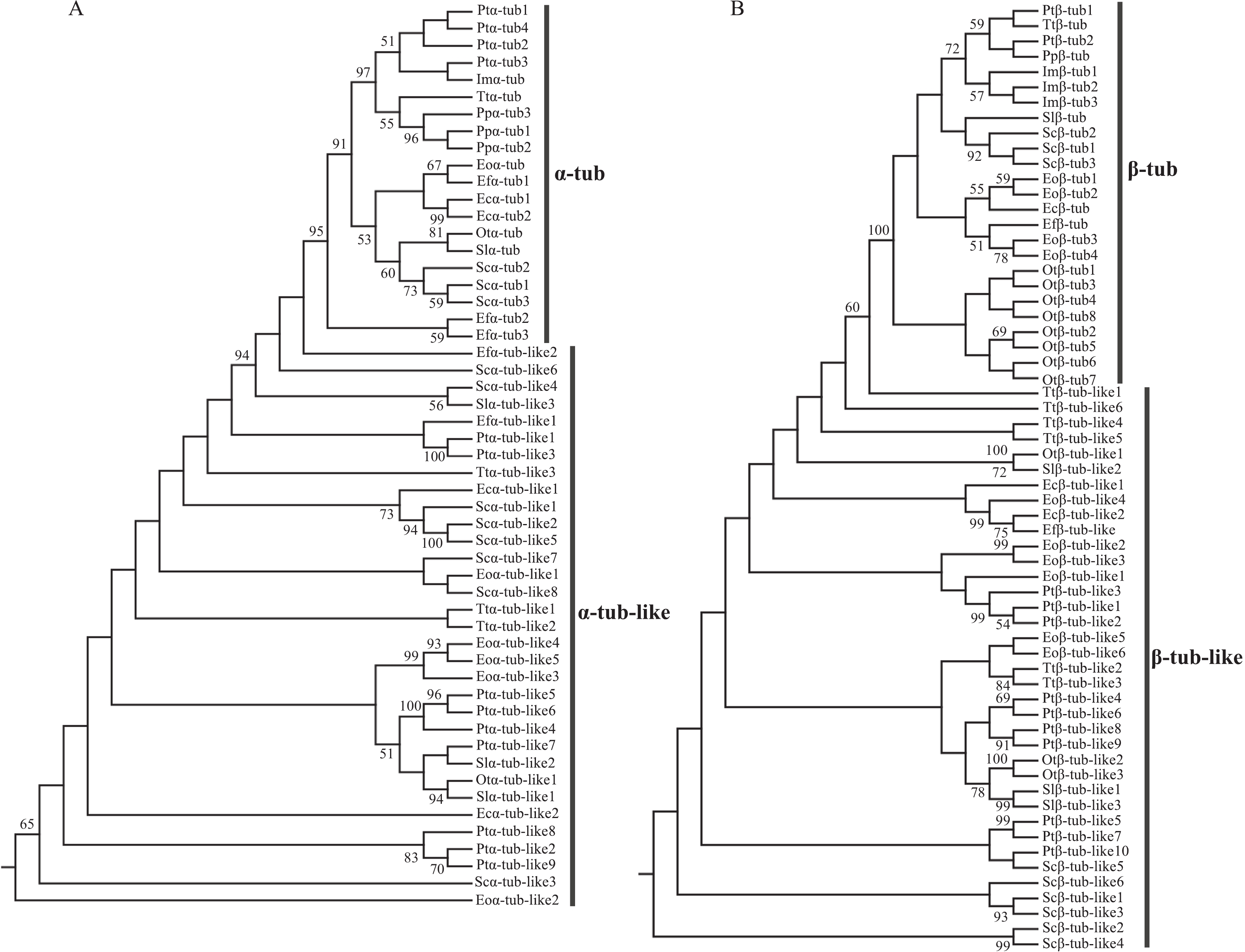IDENTIFICATION AND EVOLUTION ANALYSIS OF TUBULIN SUPERFAMILY GENES IN EUPLOTES OCTOCARINATUS
-
摘要: 为了系统分析八肋游仆虫(Euplotes octocarinatus)微管蛋白基因家族, 从八肋游仆虫大核基因组中共鉴定得到20个微管蛋白基因, 基于同源比对及系统进化分析, 将其归入α、β、γ、δ、ε及η六个微管蛋白亚家族; 多序列比对及Western blot结果显示八肋游仆虫η微管蛋白基因在翻译过程中需发生一次+1位编程性核糖体移码, 其移码位点为AAA-TAA; 所有自由生纤毛虫都含有多个α和β微管蛋白基因亚型, 可能用于组成不同的微管结构。研究为后续深入探讨八肋游仆虫微管蛋白的生物学功能及微管多样性奠定了基础。Abstract: Microtubules represent one of the major cytoskeletal filament systems of all eukaryotic cells. They play a key role in spatial arrangement of the organelles, intracellular transport, nuclear and cell division, and ciliar motility. Ciliates are ideal model organisms for studying the functional diversity of tubulins. Here, a total of 20 tubulin genes were identified in the macronuclear genome of the ciliate Euplotes octocarinatus. Based on ortholog comparisons and phylogenetic analysis, these genes were clustered into six groups: α-, β-, γ-, δ-, ε- and η-tubulins. Sequence analysis and western blots suggested that the η-tubulin gene of E. octocarinatus required a +1 programmed ribosomal frameshifting to produce complete protein product. The slippery sequence is AAATAAT. We further systematically identified tubulin genes from 9 other ciliates and compared them with E. octocarinatus. The α- and β-tubulins of all investigated free-living ciliates are encoded by multigene families, and each tubulin isotype may be used to form distinct tubulin structures. Phylogenetic analysis showed that α- and β-tubulin genes underwent multiple independent duplications and losses in ciliate. Our study lays a foundation for studying the biological function of tubulins and exploring the mechanisms of microtubule diversity.
-
Keywords:
- Euplotes octocarinatus /
- Tubulin /
- Sequence analysis /
- Phylogenetic analysis
-
微管蛋白(Tubulin)是真核生物中含量最丰富的蛋白质, 是构成细胞骨架的主要成分, 在细胞分裂、胞内运输及纤毛和鞭毛运动等过程中发挥关键作用。真核生物的微管蛋白由多个高度保守的亚家族组成[1]。α、β和γ微管蛋白广泛存在于所有的真核生物中, 早期被认为是该蛋白家族中仅有的成员[2]。α微管蛋白和β微管蛋白以异二聚体形式头尾相连形成线性原丝, 是组成微管的基本模块。γ微管蛋白是微管组成中心(Microtubule organizing center, MTOC)的组成成分, 在微管组装的成核过程中发挥重要作用。在随后的研究中微管蛋白家族新成员不断被发现[3], 通过遗传突变的方法, 分别在衣滴虫(Chlamydomonas)和草履虫(Paramecium)中发现了δ和η微管蛋白[4, 5], 这2种微管蛋白的突变, 都会导致基体(Basal body)功能的缺陷。ε微管蛋白首次在哺乳动物中报道[6], 免疫荧光定位显示其定位于中心体区域。目前通常将真核生物微管蛋白家族分为α、β、γ、δ、ε和η六个亚家族[7, 8]。
纤毛虫是一类单细胞真核生物, 细胞表面普遍存在纤毛或纤毛器, 而且单个细胞中含有多种形态和功能迥异的微管结构, 例如嗜热四膜虫(Tetrahymena thermophila)细胞中有多达17种微管结构[9]。因此纤毛虫是研究微管组装及异质性(Heterogeneity)的模式生物[10]。目前关于纤毛虫微管蛋白的报道主要集中在四膜虫和草履虫中, 关于其他纤毛虫的研究较少。近年来, 多种纤毛虫的大核基因组测序已完成, 使得我们可以对处于不同进化地位的纤毛虫中微管蛋白基因家族进行系统分析。
游仆虫(Euplotes)是纤毛虫中进化最为复杂和高等的类群之一, 其细胞结构复杂, 有背腹分化及横微管束等复杂的微管胞器[11]。本研究利用八肋游仆虫(Euplotes octocarinatus)大核基因组数据库[12, 13], 对其微管蛋白基因进行了鉴定和亚家族分类, 并与其他纤毛虫进行了比较分析; 利用多序列比对及Western blot证实八肋游仆虫η微管蛋白基因是+1位编程性核糖体移码基因, 为后续深入研究游仆虫微管蛋白的生物学功能奠定了基础。
1. 材料与方法
1.1 主要材料和试剂
八肋游仆虫由本课题组培养; α微管蛋白抗体和山羊抗兔IgG(IRDye® 800CW)二抗购自Abcam公司, BCA蛋白质浓度测定试剂盒购自碧云天生物技术公司, 蛋白Marker购自生工生物工程(上海)股份有限公司, 其余为国产分析纯试剂。
1.2 数据来源
八肋游仆虫基因组及转录组数据由本实验室前期测得[12, 13]。嗜热四膜虫、第四双小核草履虫(P. tetraurelia)、三棱尖毛虫(Oxytricha trifallax)、浮萍棘尾虫(Stylonychia lemnae)、多子小瓜虫(Ichthyophthirius multifiliis)和天蓝喇叭虫(Stentor coeruleus)的相关数据分别下载自其基因组数据库网站(Ciliates.org, http://ciliates.org/index.php/home/welcome); 水滴伪康纤虫(Pseudocohnilembus persalinus)的相关数据下载自PPGD(http://ciliates.ihb.ac.cn/database/home/#pp)、厚游仆虫(E. crassus)及南极嗜冷游仆虫(E. forcardii)的基因组数据下载自GenBank数据库[15], 大肠杆菌的丝状温度敏感蛋白(Filamentous thermosensitive protein Z, FtsZ)序列下载自GenBank数据库(KIH34997.1)。用于构建进化树的各物种的18S rRNA序列均下载自GenBank数据库: E. octocarinatus(AJ310489.1)、E. crassus (AJ310492.1)、E. focardii(EF094961.1)、I. multifiliis(KJ690569.1)、P. persalinus(AY835669.1)、S. coeruleus(AM713189.1)、O. trifallax(FJ545743.1)、S. lemnae(AM086654.1)、T. thermophila(M10932.1)、P. tetraurelia(KY852452.1)和Homo sapiens(M10098.1)。
1.3 八肋游仆虫微管蛋白基因的鉴定
草履虫的微管蛋白基因家族最为完整, 因此本研究利用其微管蛋白氨基酸序列作为queries对八肋游仆虫基因组数据库进行tblastn搜索(E-value≤0.01), 然后将鉴定得到的微管蛋白基因序列作为queries, 对NCBI的非冗余蛋白数据库(Non-redundant protein sequences database)进行Blastx搜索(E-value≤10−5), 检查每条序列Blastx结果的匹配项是否为微管蛋白, 根据Blastx结果中匹配项的注释信息, 初步将其归入6个微管蛋白亚家族中。接着对八肋游仆虫转录组数据库进行Blastn搜索, 找到对应的转录本。
1.4 八肋游仆虫微管蛋白系统进化树的构建
以大肠杆菌的FtsZ蛋白作为外类群, 利用软件MEGA5.1[16]进行多序列比对, 通过手工进行了相应的校正, 利用最大似然法构建系统进化树, 并进行1000次自展(Bootstrap)检验来评估进化树分支可信度。
1.5 生物信息学分析
利用在线分析软件EMBOSS中的GetOrf程序预测微管蛋白的氨基酸长度[17]; 利用ExPASy(http://web.expasy.org/compute_pi/)在线预测其理论分子量; 利用Clustal X (v2.0)[18]的多序列比较程序(Do complete alignment)对八肋游仆虫、第四双小核草履虫、厚游仆虫及嗜冷游仆虫的η微管蛋白进行多序列比对分析(默认参数)。
1.6 抗体的制备及Western blot分析
八肋游仆虫η微管蛋白多克隆抗体由北京奥维亚生物技术有限公司定制。选取位于移码位点下游的肽段(Glu257-Glu-Glu-Leu-Ser-Cys-Asp-Lys-Asn-Lys-Asp-Trp-Gln-Asp270)进行多肽合成, 用合成的多肽免疫兔子制备抗体。提取八肋游仆虫总蛋白, BCA试剂盒测定蛋白质浓度, 按相等蛋白质上样量用10%的SDS聚丙烯酰胺凝胶进行分离, 转膜, 用封闭液封闭, 按照1﹕600的比例稀释Eoη-tub多克隆抗体, 4℃过夜孵育; 加入对应的二抗, 室温温育1h, 用PBST洗膜4次, 每次10min, 用Odyssey红外激光成像仪扫膜成像分析。
2. 结果
2.1 八肋游仆虫微管蛋白基因的鉴定及分类
以第四双小核草履虫的微管蛋白作为查询序列, 通过BLAST搜索, 最终从八肋游仆虫基因组中鉴定得到20个微管蛋白基因(表 1), 基于同源比对结果及在生物进化树中的位置, 将所有的微管蛋白基因分为α、β、γ、δ、ε及η六个亚家族(图 1)。
表 1 八肋游仆虫微管蛋白基因的分子特征Table 1. Molecular characteristics of the tubulin genes in Euplotes octocarinatus基因/亚家族
Gene/Subfamily基因组ID
Genome ID内含子个数Introns number 5′前导序列长度
5′ leader (bp)3′尾端序列长度
3′ tailer (bp)RPKM值RPKM value 氨基酸长度Length (aa) 分子量Molecular weight (kD) α-tubulin Eoα-tub Contig18065 0 78 99 2601.66 450 49.62 Eoα-tub-like-1 Contig28852 0 51 71 0.22 445 50.73 Eoα-tub-like-2 Contig27230 0 40 31 1.91 483 55.97 Eoα-tub-like-3 Contig3451 0 57 33 1.54 459 51.62 Eoα-tub-like-4 Contig27158 0 38 46 / 456 51.56 Eoα-tub-like-5 Contig26869 0 38 57 / 457 52.34 β-tubulin Eoβ-tub1 Contig5259 0 50 127 231.98 444 49.63 Eoβ-tub2 Contig5984 0 54 51 1.15 444 49.60 Eoβ-tub3 Contig8213 0 54 143 168.77 443 49.65 Eoβ-tub4 Contig4144198 0 55 143 131.57 443 49.60 Eoβ-tub-like-1 Contig18362 2 33 44 2.19 435 49.87 Eoβ-tub-like-2 Contig25579 5 31 38 1.69 454 51.88 Eoβ-tub-like-3 Contig29123 4 35 101 1.71 444 50.90 Eoβ-tub-like-4 Contig6445 0 79 79 169.66 467 52.44 Eoβ-tub-like-5 Contig4144404 1 41 38 3.42 433 48.93 Eoβ-tub-like-6 Contig9575 0 39 41 1.08 505 58.35 γ-tubulin Eoγ-tub Contig11092 2 49 82 18.528 461 52.04 δ-tubulin Eoδ-tub Contig24288 1 44 13 1.03 423 48.54 ε-tubulin Eoε-tub Contig17307 2 80 36 3.96 499 56.51 η-tubulin Eoη-tub Contig8731 2 34 51 5.89 410 46.66 ![]() 图 1 八肋游仆虫微管蛋白基因家族序列分析用八肋游仆虫(Eo, 粗体)、嗜热四膜虫(Tt)及第四双小核草履虫(Pt)的微管蛋白构建的最大似然树, 大肠杆菌的FtsZ蛋白作为外类群。自展值以百分比的形式列于每一个节点Figure 1. Sequence analysis of the tubulin gene families from Euplotes octocarinatusThe maximum likelihood phylogenetic tree based on the deduced amino acid sequences of tubulin genes in Euplotes octocarinatus (Eo, in bold), Tetrahymena thermophila (Tt) and Paramecium tetraurelia (Pt). The FtsZ protein of Escherichia coli (Ec) was used as outgroup. Bootstrap values are displayed as percentages at each tree node
图 1 八肋游仆虫微管蛋白基因家族序列分析用八肋游仆虫(Eo, 粗体)、嗜热四膜虫(Tt)及第四双小核草履虫(Pt)的微管蛋白构建的最大似然树, 大肠杆菌的FtsZ蛋白作为外类群。自展值以百分比的形式列于每一个节点Figure 1. Sequence analysis of the tubulin gene families from Euplotes octocarinatusThe maximum likelihood phylogenetic tree based on the deduced amino acid sequences of tubulin genes in Euplotes octocarinatus (Eo, in bold), Tetrahymena thermophila (Tt) and Paramecium tetraurelia (Pt). The FtsZ protein of Escherichia coli (Ec) was used as outgroup. Bootstrap values are displayed as percentages at each tree node八肋游仆虫α微管蛋白(Eoα-tub)亚家族共包含6个基因, 其中Contig18065的氨基酸序列与已报道的Eoα-tub仅1个氨基酸不同[19], 其余5个基因与已报道的Eoα-tub氨基酸序列一致性较低(30.36%—42.18%), 但BLASTP比对结果中均为其他生物的α微管蛋白, 参考嗜热四膜虫微管蛋白基因的命名方法[20], 我们将这5个非经典的α微管蛋白同源基因命名为α-tub-like。β微管蛋白亚家族包括10个基因, 其中4个基因与已报道的Eoβ-tub的序列一致性均大于95%[19], 其余序列同源性较低的6个基因命名为β-tub-like。γ、δ、ε及η四个亚家族各包含一个基因, 没有其他直系同源基因(表 1)。
基于转录组数据, 对所有微管蛋白基因的内含子个数、氨基酸长度、理论分子量及RPKM值进行了分析(表 1)。在转录组数据库中, 找到了除Eoα-tub-like-4和Eoα-tub-like-5外所有微管蛋白基因的转录本。虽然α和β微管蛋白亚家族都有多个基因, 但同一亚家族不同成员的表达水平存在明显差别(表 1)。在α亚家族中, Eoα-tub的RPKM值为2601.66, 远高于几种Eoα-tub-like基因。在β亚家族中, Eoβ-tub1、Eoβ-tub3、Eoβ-tub4及Eoβ-tub-like-4的RPKM值明显高于亚家族的其他成员, 这一结果表明同一亚家族的不同基因存在表达的特异性, 暗示其具有不同的生物学功能。
2.2 八肋游仆虫微管蛋白基因微染色体结构分析
将转录本序列与基因组DNA序列进行比对, 对八肋游仆虫微管蛋白基因微染色体的结构进行了分析(图 2)。所有的微染色体都含有两端的端粒结构, 由于Eoα-tub-like-4和Eoα-tub-like-5没有转录本, 根据同源比对结果对其基因结构进行了预测。α亚家族的所有成员都没有内含子, β亚家族中, 所有Eoβ-tub基因都没有内含子, 但4个Eoβ-tub-like基因含有一个或多个内含子, 而且这些内含子的位置和长度差异较大, 最长的内含子1086 bp, 最短的仅25 bp, 其他亚家族成员均含有一个或两个内含子。值得注意的是, Eoη-tub基因含有一个读框内终止密码子, 我们推测该基因在翻译过程中会发生+1位编程性核糖体移码(Programmed ribosomal frameshifting, PRF)。
2.3 Eoη-tub基因是+1位编程性核糖体移码基因
游仆虫中存在高频率的编程性核糖体移码现象[12, 14, 15], 在分析Eoη-tub基因结构时, 发现该基因中存在2个部分重叠的开放阅读框(图 3A), ORF1由63位的起始密码子ATG1和748位的终止密码子TAA1组成, 编码一个219个氨基酸的序列; ORF2由722位的ATG2和1379位的TAA2组成, 编码一个200个氨基酸的序列。只有在TAA1处发生一次+1位移码(Putative ORF), 才能编码由411个氨基酸组成的完整蛋白质。
![]() 图 3 八肋游仆虫η微管蛋白基因的表达需要编程性核糖体移码A. 移码区域的详细分析。标出了Eoη-tub基因的起始密码子和终止密码子的位置, 不同起始密码子和终止密码子组合相对应的三个开放阅读框。假定的滑动序列AAAUAAU用浅色字体表示, 理论上0读框和+1读框翻译的氨基酸序列分别列于mRNA序列的上方和下方, ORF表示开放阅读框(Open reading frame); B. 八肋游仆虫η微管蛋白移码位点附近的氨基酸序列与Paramecium tetraurelia (Pt)、Euplotes focardii (Ef) 及Euplotes crassus (Ec)同源蛋白的比对, 推测的移码位点用黑色圆点表示; C. 利用制备的Eoη-tub多克隆抗体进行western blot分析, 泳道1和2分别表示用和不用抗原多肽孵育得到的结果。箭头所指为Eoη-tub的位置, Eoα-tub作为内参, Mr代表蛋白MarkerFigure 3. Programmed ribosomal frameshifting is likely required for expression of gene encoding η-tubulin in Euplotes octocarinatusA. Close-up of the frameshift region. Relative positions of the multiple start and stop codons in the Eoη-tub gene sequence were shown. The putative slippery sequence AAAUAAU motif is shown in light type. Conceptual translations in the 0 reading frame and +1 reading frame are aligned above and below the mRNA sequence, respectively. ORF, open reading frame. B. The parts of the putative frameshift site of the η-tubulin of E. octocarinatus (Eo) are aligned with the respective homologous proteins from P. tetraurelia (Pt), E. focardii (Ef) and E. crassus (Ec). The putative location of the frameshift is marked by black dot. C. Western blot of total cell lysates probed with Eoη-tub antibody in absence, or presence of the relative antigenic peptide (lanes 1 and 2, respectively). The Eoη-tub recognition is indicated by arrowhead. Eoα-tub is used as the internal control, Mr represents protein Marker
图 3 八肋游仆虫η微管蛋白基因的表达需要编程性核糖体移码A. 移码区域的详细分析。标出了Eoη-tub基因的起始密码子和终止密码子的位置, 不同起始密码子和终止密码子组合相对应的三个开放阅读框。假定的滑动序列AAAUAAU用浅色字体表示, 理论上0读框和+1读框翻译的氨基酸序列分别列于mRNA序列的上方和下方, ORF表示开放阅读框(Open reading frame); B. 八肋游仆虫η微管蛋白移码位点附近的氨基酸序列与Paramecium tetraurelia (Pt)、Euplotes focardii (Ef) 及Euplotes crassus (Ec)同源蛋白的比对, 推测的移码位点用黑色圆点表示; C. 利用制备的Eoη-tub多克隆抗体进行western blot分析, 泳道1和2分别表示用和不用抗原多肽孵育得到的结果。箭头所指为Eoη-tub的位置, Eoα-tub作为内参, Mr代表蛋白MarkerFigure 3. Programmed ribosomal frameshifting is likely required for expression of gene encoding η-tubulin in Euplotes octocarinatusA. Close-up of the frameshift region. Relative positions of the multiple start and stop codons in the Eoη-tub gene sequence were shown. The putative slippery sequence AAAUAAU motif is shown in light type. Conceptual translations in the 0 reading frame and +1 reading frame are aligned above and below the mRNA sequence, respectively. ORF, open reading frame. B. The parts of the putative frameshift site of the η-tubulin of E. octocarinatus (Eo) are aligned with the respective homologous proteins from P. tetraurelia (Pt), E. focardii (Ef) and E. crassus (Ec). The putative location of the frameshift is marked by black dot. C. Western blot of total cell lysates probed with Eoη-tub antibody in absence, or presence of the relative antigenic peptide (lanes 1 and 2, respectively). The Eoη-tub recognition is indicated by arrowhead. Eoα-tub is used as the internal control, Mr represents protein Marker为了证实这一假设, 首先将Eoη-tub蛋白与草履虫及另外2种游仆虫的同源蛋白进行了多序列比对(图 3B), 结果显示移码位点的赖氨酸(K)和天冬酰胺(N)高度保守。此外, 利用制备的Eoη-tub多克隆抗体通过Western blots检测了八肋游仆虫细胞内是否存在全长的Eoη-tub蛋白。如图 3C所示, Western blot检测到一条大小与推测的全长蛋白分子量(46.66 kD)非常接近的条带。以上结果表明, Eoη-tub基因确实为+1位编程性核糖体移码基因, 其滑动序列为AAA-TAA-T。
2.4 不同纤毛虫中微管蛋白基因的比较分析
为了对纤毛虫微管蛋白进行系统分析, 对另外7种大核基因组已测序的纤毛虫的微管蛋白基因进行了鉴定(图 4)。人、嗜热四膜虫和第四双小核草履虫的数据来自前期报道[7, 9, 20]。我们保留了前期研究人员对草履虫及四膜虫微管蛋白基因亚家族的分类, 本研究分析的几种纤毛虫微管蛋白基因全部归入α、β、γ、δ、ε及η六个亚家族中。
![]() 图 4 八肋游仆虫与其他纤毛虫中微管蛋白基因的比较系统发育树是利用不同物种的18S rRNA序列采用最大似然法构建的, 以人作为外群。自展值以百分比的形式列于每一个节点, 每个微管蛋白亚家族的基因个数列在右边Figure 4. Comparison of tubulin genes in Euplotes octocarinatus and other ciliatesPhylogenetic tree was constructed using the maximum likelihood method based on the 18S rRNA sequences. Homo sapiens is an outgroup. Bootstrap values are displayed as percentages at each tree node. The gene number of each tubulin subfamily was indicated on the right
图 4 八肋游仆虫与其他纤毛虫中微管蛋白基因的比较系统发育树是利用不同物种的18S rRNA序列采用最大似然法构建的, 以人作为外群。自展值以百分比的形式列于每一个节点, 每个微管蛋白亚家族的基因个数列在右边Figure 4. Comparison of tubulin genes in Euplotes octocarinatus and other ciliatesPhylogenetic tree was constructed using the maximum likelihood method based on the 18S rRNA sequences. Homo sapiens is an outgroup. Bootstrap values are displayed as percentages at each tree node. The gene number of each tubulin subfamily was indicated on the right所有的纤毛虫都含有六类微管蛋白基因, 但每个微管蛋白亚家族所含的基因个数不同。大多数纤毛虫的α和β微管蛋白亚家族都含有两个或两个以上的基因, 而多子小瓜虫(Ichthyophthirius multifiliis)仅有一个α微管蛋白基因, 水滴伪康纤虫(Pseudocohnilembus persalinus)仅有一个β微管蛋白基因。几乎所有纤毛虫的γ微管蛋白基因个数都不超过2个, 仅天蓝喇叭虫(Stentor coeruleus)含有3个γ微管蛋白基因。大部分纤毛虫仅含有1个δ、ε及η微管蛋白基因, 天蓝喇叭虫含有2个ε微管蛋白基因, 水滴伪康纤虫的δ和ε微管蛋白基因各有2个。此外, 所有自由生纤毛虫都含有α-tub-like和β-tub-like微管蛋白基因, 但寄生虫多子小瓜虫和兼性寄生的水滴伪康纤虫仅有经典的α和β微管蛋白基因, 没有鉴定到tub-like微管蛋白基因。
本研究分析的3种游仆虫基因组中, 淡水种八肋游仆虫只有1个经典的α微管蛋白基因, 而海水种厚游仆虫和嗜冷游仆虫含有2—3个经典的α微管蛋白基因; 八肋游仆虫有5个α-tub-like微管蛋白基因, 而厚游仆虫和嗜冷游仆虫只有2个α-tub-like微管蛋白基因。八肋游仆虫的β微管蛋白基因亚家族成员较多, 包括4个经典的β微管蛋白基因6个β-tub-like微管蛋白基因, 厚游仆虫只有1个经典的β微管蛋白基因和2个β-tub-like微管蛋白基因; 嗜冷游仆虫有4个经典的β微管蛋白基因和1个β-tub-like微管蛋白基因。
对纤毛虫α及β微管蛋白亚家族成员进行系统发育分析(图 5), 结果表明所有纤毛虫中经典的α/β微管蛋白明显单独聚为一枝, 而α-tub-like和β-tub-like微管蛋白聚为多个不同的进化枝, 暗示纤毛虫的α-tub-like和β-tub-like微管蛋白具有多个独立的起源。此外, 某些纤毛虫的微管蛋白基因在进化过程发生了基因复制事件, 例如嗜热四膜虫Ttβ-tub-like4和Ttβ-tub-like5基因及厚游仆虫的2个经典α微管蛋白基因Ecα-tub1和Ecα-tub2, 在进化树上位于直接相邻的2个分枝, 表明它们来源于种内的基因复制事件。以上结果表明, 纤毛虫微管蛋白基因在进化过程中经历了复杂的基因复制和丢失过程。
![]() 图 5 纤毛虫α及β微管蛋白亚家族系统发育分析基于不同纤毛虫α(A)及β(B)微管蛋白亚家族序列构建的最大似然树, 大肠杆菌的FtsZ蛋白作为外类群, 自展值以百分比的形式列于每一个节点。Pt. 第四双小核草履虫; Tt. 嗜热四膜虫; Pp. 水滴伪康纤虫; Im. 多子小瓜虫; Sc. 天蓝喇叭虫; Ot. 三棱尖毛虫; Sl. 浮萍棘尾虫; Ec. 厚游仆虫; Ef. 嗜冷游仆虫; Eo. 八肋游仆虫Figure 5. Phylogenetic analysis of α and β tubulin subfamilies in ciliatesPhylogenetic tree was constructed using the maximum likelihood method based on the deduced amino acid sequences of α tubulin subfamilies sequences (A) and β tubulin subfamilies sequences (B) from different ciliates. The FtsZ protein of Escherichia coli was used as outgroup. Bootstrap values are displayed as percentages at each tree node. Pt. Paramecium tetraurelia; Tt. Tetrahymena thermophile; Pp. Pseudocohnilembus persalinus; Im. Ichthyophthirius multifiliis; Sc. Stentor coeruleus; Ot. Oxytricha trifallax; Sl. Stylonychia lemnae; Ec. Euplotes crassus; Eh. Euplotes harpa; Eo. Euplotes octocarinatus
图 5 纤毛虫α及β微管蛋白亚家族系统发育分析基于不同纤毛虫α(A)及β(B)微管蛋白亚家族序列构建的最大似然树, 大肠杆菌的FtsZ蛋白作为外类群, 自展值以百分比的形式列于每一个节点。Pt. 第四双小核草履虫; Tt. 嗜热四膜虫; Pp. 水滴伪康纤虫; Im. 多子小瓜虫; Sc. 天蓝喇叭虫; Ot. 三棱尖毛虫; Sl. 浮萍棘尾虫; Ec. 厚游仆虫; Ef. 嗜冷游仆虫; Eo. 八肋游仆虫Figure 5. Phylogenetic analysis of α and β tubulin subfamilies in ciliatesPhylogenetic tree was constructed using the maximum likelihood method based on the deduced amino acid sequences of α tubulin subfamilies sequences (A) and β tubulin subfamilies sequences (B) from different ciliates. The FtsZ protein of Escherichia coli was used as outgroup. Bootstrap values are displayed as percentages at each tree node. Pt. Paramecium tetraurelia; Tt. Tetrahymena thermophile; Pp. Pseudocohnilembus persalinus; Im. Ichthyophthirius multifiliis; Sc. Stentor coeruleus; Ot. Oxytricha trifallax; Sl. Stylonychia lemnae; Ec. Euplotes crassus; Eh. Euplotes harpa; Eo. Euplotes octocarinatus3. 讨论
作为细胞骨架的主要成分, 微管蛋白广泛存在于各种真核生物中, 因此微管蛋白基因序列常被用于物种的系统发生研究[21, 22]。近年来大量生物的基因组被测定, 使研究人员能够从整体水平对微管蛋白基因的多样性进行探讨[7, 8]。不同真核生物含有的微管蛋白亚家族种类不同, α、β和γ微管蛋白亚家族保守存在于所有真核生物中, 而δ、ε和η微管蛋白只存在于某些真核生物中[7, 23]。纤毛虫拥有最为丰富的微管结构[24], 本研究对八肋游仆虫的微管蛋白基因进行了鉴定和亚家族分类, 结果表明其含有6个微管蛋白亚家族(表 1)。Erin等[23]发现缺少ε微管蛋白的生物一般也缺少δ和η微管蛋白, 而含有ε微管蛋白的生物通常也至少含有δ和η微管蛋白中的一种, 这3种微管蛋白形成了一个保守的进化模块。缺少这3种微管蛋白的生物通常没有中心粒结构或者缺少中心粒附属物。例如, 酵母(Yeast)和秀丽隐杆线虫(Caenorhabditis elegans)没有正常的中心粒, 因此它们都不含有δ、ε及η微管蛋白[8, 23]。纤毛虫虽然没有典型的中心粒和中心体, 但存在功能类似的基体[25], 本研究分析的所有纤毛虫中都含有这3种微管蛋白基因(图 4)。在纤毛虫中, 这3种微管蛋白的破坏会导致显著的细胞骨架缺陷, 说明它们在基体与细胞骨架的相互作用中具有重要作用, 例如四膜虫ε微管蛋白的破坏会导致基体的定位和间距发生紊乱[26], 草履虫η微管蛋白的突变会导致基体复制过程受损[5]。
在大部分真核生物中, α和β微管蛋白都是由多基因家族编码的, 每个基因编码1个独特的蛋白亚型[27]。Liang等[19, 28]从八肋游仆虫中克隆到1个α微管蛋白和2个β微管蛋白基因。本研究从其大核基因组中共鉴定到6个α微管蛋白和10个β微管蛋白基因, 除经典的α和β微管蛋白基因外, 还鉴定到5个非经典的α-tub-like和6个β-tub-like微管蛋白基因。“multi-tubulin”假说认为, 细胞内每1种微管蛋白亚型发挥特定的功能, 组成不同的微管结构[3]。例如, 人类的某些先天性神经系统疾病是由不同的微管蛋白亚型突变引起的[29]。在果蝇中, 精子尾部基因丝的装配需要特定的微管蛋白亚型形成中心微管对[30]。本研究发现α-tub-like和β-tub-like微管蛋白基因广泛存在于所有自由生纤毛虫基因组中, 而寄生的多子小瓜虫和兼性寄生的水滴伪康纤虫只含有经典的α和β微管蛋白(图 4)。Sandra等[31]对嗜热四膜虫中不同β微管蛋白亚型的细胞定位、结构及生物功能进行了比较分析, 发现经典的β微管蛋白BTU2存在于体纤毛及基体, 而非经典的β-like微管蛋白BLT1和BLT4参与形成大核的微管结构及小核的有丝分裂器(Mitotic apparatus), 此外, BLT1还参与形成配对时期小核中减数分裂器(Meiotic apparatus)的微管结构。我们推测在其他自由生纤毛虫中, 这些tub-like微管蛋白亚型可能也具有类似的功能, 用于构建功能不同的微管结构。此外, 八肋游仆虫不同微管蛋白亚型之间RPKM值差异较大(表 1), 暗示细胞内不同亚型的表达受到发育阶段的严格调控。有研究表明不同的微管蛋白在细胞中可通过翻译后修饰产生具有不同功能的微管结构[27], 多子小瓜虫及水滴伪康纤虫不含有α-tub-like和β-tub-like微管蛋白基因, 它们可能是利用多种翻译后修饰来形成不同的微管结构。
本研究证实Eoη-tub基因是一个+1位编程性核糖体移码基因(图 3)。游仆虫中存在高频率的编程性核糖体移码现象, 且移码类型多样[12, 15]。游仆虫中的移码基因中大部分是酶, 尤其是蛋白激酶[12], 本研究发现参与基体组装的η微管蛋白也是编程性核糖体移码基因, 进一步说明在游仆虫中编程性核糖体移码被广泛应用于各种基因的表达调控, 并不局限于某一类基因。此外, 前期研究发现八肋游仆虫编程性核糖体移码基因的表达丰度明显低于正常基因[14], 在本研究鉴定出的20种微管蛋白中, Eoη-tub基因的表达量较低(RPKM值5.89), 而其他表达量较高的微管蛋白基因在翻译过程中均不需要编程性核糖体移码。这一结果暗示, 虽然游仆虫可利用精密的移码监控机制来保证细胞内移码的精确进行, 但它仍然会影响核糖体的翻译速度, 所以在进化过程中, 仅表达丰度较低的基因中保留了移码位点。在真核生物鸟氨酸脱羧酶抗酶及细菌肽链释放因子等被深入研究的PRF基因中, 其移码序列及移码类型都是非常保守的[32, 33]。在分析E. focardii及 E. crassus的η微管蛋白基因过程中发现, Ef η-tub基因不发生PRF, 而Ec η-tub基因需要发生一次+1 PRF和一次+2 PRF, 但移码位点与八肋游仆虫Eo η-tub基因的移码位点并不相同, 表明游仆虫中的PRF在进化中并不保守。
-
图 1 八肋游仆虫微管蛋白基因家族序列分析
用八肋游仆虫(Eo, 粗体)、嗜热四膜虫(Tt)及第四双小核草履虫(Pt)的微管蛋白构建的最大似然树, 大肠杆菌的FtsZ蛋白作为外类群。自展值以百分比的形式列于每一个节点
Figure 1. Sequence analysis of the tubulin gene families from Euplotes octocarinatus
The maximum likelihood phylogenetic tree based on the deduced amino acid sequences of tubulin genes in Euplotes octocarinatus (Eo, in bold), Tetrahymena thermophila (Tt) and Paramecium tetraurelia (Pt). The FtsZ protein of Escherichia coli (Ec) was used as outgroup. Bootstrap values are displayed as percentages at each tree node
图 3 八肋游仆虫η微管蛋白基因的表达需要编程性核糖体移码
A. 移码区域的详细分析。标出了Eoη-tub基因的起始密码子和终止密码子的位置, 不同起始密码子和终止密码子组合相对应的三个开放阅读框。假定的滑动序列AAAUAAU用浅色字体表示, 理论上0读框和+1读框翻译的氨基酸序列分别列于mRNA序列的上方和下方, ORF表示开放阅读框(Open reading frame); B. 八肋游仆虫η微管蛋白移码位点附近的氨基酸序列与Paramecium tetraurelia (Pt)、Euplotes focardii (Ef) 及Euplotes crassus (Ec)同源蛋白的比对, 推测的移码位点用黑色圆点表示; C. 利用制备的Eoη-tub多克隆抗体进行western blot分析, 泳道1和2分别表示用和不用抗原多肽孵育得到的结果。箭头所指为Eoη-tub的位置, Eoα-tub作为内参, Mr代表蛋白Marker
Figure 3. Programmed ribosomal frameshifting is likely required for expression of gene encoding η-tubulin in Euplotes octocarinatus
A. Close-up of the frameshift region. Relative positions of the multiple start and stop codons in the Eoη-tub gene sequence were shown. The putative slippery sequence AAAUAAU motif is shown in light type. Conceptual translations in the 0 reading frame and +1 reading frame are aligned above and below the mRNA sequence, respectively. ORF, open reading frame. B. The parts of the putative frameshift site of the η-tubulin of E. octocarinatus (Eo) are aligned with the respective homologous proteins from P. tetraurelia (Pt), E. focardii (Ef) and E. crassus (Ec). The putative location of the frameshift is marked by black dot. C. Western blot of total cell lysates probed with Eoη-tub antibody in absence, or presence of the relative antigenic peptide (lanes 1 and 2, respectively). The Eoη-tub recognition is indicated by arrowhead. Eoα-tub is used as the internal control, Mr represents protein Marker
图 4 八肋游仆虫与其他纤毛虫中微管蛋白基因的比较
系统发育树是利用不同物种的18S rRNA序列采用最大似然法构建的, 以人作为外群。自展值以百分比的形式列于每一个节点, 每个微管蛋白亚家族的基因个数列在右边
Figure 4. Comparison of tubulin genes in Euplotes octocarinatus and other ciliates
Phylogenetic tree was constructed using the maximum likelihood method based on the 18S rRNA sequences. Homo sapiens is an outgroup. Bootstrap values are displayed as percentages at each tree node. The gene number of each tubulin subfamily was indicated on the right
图 5 纤毛虫α及β微管蛋白亚家族系统发育分析
基于不同纤毛虫α(A)及β(B)微管蛋白亚家族序列构建的最大似然树, 大肠杆菌的FtsZ蛋白作为外类群, 自展值以百分比的形式列于每一个节点。Pt. 第四双小核草履虫; Tt. 嗜热四膜虫; Pp. 水滴伪康纤虫; Im. 多子小瓜虫; Sc. 天蓝喇叭虫; Ot. 三棱尖毛虫; Sl. 浮萍棘尾虫; Ec. 厚游仆虫; Ef. 嗜冷游仆虫; Eo. 八肋游仆虫
Figure 5. Phylogenetic analysis of α and β tubulin subfamilies in ciliates
Phylogenetic tree was constructed using the maximum likelihood method based on the deduced amino acid sequences of α tubulin subfamilies sequences (A) and β tubulin subfamilies sequences (B) from different ciliates. The FtsZ protein of Escherichia coli was used as outgroup. Bootstrap values are displayed as percentages at each tree node. Pt. Paramecium tetraurelia; Tt. Tetrahymena thermophile; Pp. Pseudocohnilembus persalinus; Im. Ichthyophthirius multifiliis; Sc. Stentor coeruleus; Ot. Oxytricha trifallax; Sl. Stylonychia lemnae; Ec. Euplotes crassus; Eh. Euplotes harpa; Eo. Euplotes octocarinatus
表 1 八肋游仆虫微管蛋白基因的分子特征
Table 1 Molecular characteristics of the tubulin genes in Euplotes octocarinatus
基因/亚家族
Gene/Subfamily基因组ID
Genome ID内含子个数Introns number 5′前导序列长度
5′ leader (bp)3′尾端序列长度
3′ tailer (bp)RPKM值RPKM value 氨基酸长度Length (aa) 分子量Molecular weight (kD) α-tubulin Eoα-tub Contig18065 0 78 99 2601.66 450 49.62 Eoα-tub-like-1 Contig28852 0 51 71 0.22 445 50.73 Eoα-tub-like-2 Contig27230 0 40 31 1.91 483 55.97 Eoα-tub-like-3 Contig3451 0 57 33 1.54 459 51.62 Eoα-tub-like-4 Contig27158 0 38 46 / 456 51.56 Eoα-tub-like-5 Contig26869 0 38 57 / 457 52.34 β-tubulin Eoβ-tub1 Contig5259 0 50 127 231.98 444 49.63 Eoβ-tub2 Contig5984 0 54 51 1.15 444 49.60 Eoβ-tub3 Contig8213 0 54 143 168.77 443 49.65 Eoβ-tub4 Contig4144198 0 55 143 131.57 443 49.60 Eoβ-tub-like-1 Contig18362 2 33 44 2.19 435 49.87 Eoβ-tub-like-2 Contig25579 5 31 38 1.69 454 51.88 Eoβ-tub-like-3 Contig29123 4 35 101 1.71 444 50.90 Eoβ-tub-like-4 Contig6445 0 79 79 169.66 467 52.44 Eoβ-tub-like-5 Contig4144404 1 41 38 3.42 433 48.93 Eoβ-tub-like-6 Contig9575 0 39 41 1.08 505 58.35 γ-tubulin Eoγ-tub Contig11092 2 49 82 18.528 461 52.04 δ-tubulin Eoδ-tub Contig24288 1 44 13 1.03 423 48.54 ε-tubulin Eoε-tub Contig17307 2 80 36 3.96 499 56.51 η-tubulin Eoη-tub Contig8731 2 34 51 5.89 410 46.66 -
[1] Aylett C H S, Löwe J, Amos L A. New insights into the mechanisms of cytomotive actin and tubulin filaments [J]. International Review of Cell and Molecular Biology, 2011(292): 1-71.
[2] Oakley B R. An abundance of tubulins [J]. Trends in Cell Biology, 2000, 10(12): 537-542. doi: 10.1016/S0962-8924(00)01857-2
[3] Mckean P G, Vaughan S, Gull K. The extended tubulin superfamily [J]. Journal of Cell Science, 2001, 114(15): 2723-2733. doi: 10.1242/jcs.114.15.2723
[4] Dutcher S K, Trabuco E C. The UNI3 gene is required for assembly of basal bodies of Chlamydomonas and encodes delta-tubulin, a new member of the tubulin superfamily [J]. Molecular Biology of the Cell, 1998, 9(6): 1293-1308. doi: 10.1091/mbc.9.6.1293
[5] Ruiz F, Krzywicka A, Klotz C, et al. The SM19 gene, required for duplication of basal bodies in Paramecium, encodes a novel tubulin, eta-tubulin [J]. Current Biology, 2000, 10(22): 1451-1454. doi: 10.1016/S0960-9822(00)00804-6
[6] Chang P, Stearns T. Delta-tubulin and epsilon-tubulin: two new human centrosomal tubulins reveal new aspects of centrosome structure and function [J]. Nature Cell Biology, 2000, 2(1): 30-35. doi: 10.1038/71350
[7] Findeisen P, Muhlhausen S, Dempewolf S, et al. Six subgroups and extensive recent duplications characterize the evolution of the eukaryotic tubulin protein family [J]. Genome Biology and Evolution, 2014, 6(9): 2274-2288. doi: 10.1093/gbe/evu187
[8] Zhao Z T, Liu H Q, Luo Y P, et al. Molecular evolution and functional divergence of tubulin superfamily in the fungal tree of life [J]. Scientific Reports, 2014(4): 6746.
[9] Libusova L, Draber P. Multiple tubulin forms in ciliated protozoan Tetrahymena and Paramecium species [J]. Protoplasma, 2006, 227(2-4): 65-76. doi: 10.1007/s00709-005-0152-0
[10] Bayless B A, Navarro F M, Winey M. Motile cilia: innovation and insight from ciliate model organisms [J]. Frontiers in Cell Developmental Biology, 2019(7): 265.
[11] Méndez-Sánchez D, Mayén-Estrada R, Hu X Z. Euplotes octocarinatus Carter, 1972 (Ciliophora, Spirotrichea, Euplotidae): Considerations on its morphology, phylogeny, and biogeography [J]. European Journal of Protistology, 2020(74): 125667.
[12] Wang R L, Xiong J, Wang W, et al. High frequency of +1 programmed ribosomal frameshifting in Euplotes octocarinatus [J]. Scientific Reports, 2016, 6(1): 21139. doi: 10.1038/srep21139
[13] Wang R L, Miao W, Wang W, et al. EOGD: the Euplotes octocarinatus genome database [J]. BMC Genomics, 2018, 19(1): 63. doi: 10.1186/s12864-018-4445-z
[14] Wang R L, Zhang Z Y, Du J, et al. Large-scale mass spectrometry-based analysis of Euplotes octocarinatus supports the high frequency of +1 programmed ribosomal frameshift [J]. Scientific Reports, 2016, 6(1): 33020. doi: 10.1038/srep33020
[15] Lobanov A V, Heaphy S M, Turanov A A, et al. Position-dependent termination and widespread obligatory frameshifting in Euplotes translation [J]. Nature Structural & Molecular Biology, 2016, 24(1): 61-68.
[16] Tamura K, Peterson D, Peterson N, et al. MEGA5: molecular evolutionary genetics analysis using maximum likelihood, evolutionary distance, and maximum parsimony methods [J]. Molecular Biology and Evolution, 2011, 28(10): 2731-2739. doi: 10.1093/molbev/msr121
[17] Rice P, Longden I, Bleasby A. EMBOSS: The European molecular biology open software suite [J]. Trends in Genetics, 2000, 16(6): 276-277. doi: 10.1016/S0168-9525(00)02024-2
[18] Fábio M, Young M P, Joon L, et al. The EMBL-EBI search and sequence analysis tools APIs in 2019 [J]. Nucleic Acids Research, 2019, 47(W1): W636-W641. doi: 10.1093/nar/gkz268
[19] Liang A H, Schmidt H J, Heckmann K. The alpha- and beta-tubulin genes of Euplotes octocarinatus [J]. Journal of Eukaryotic Microbiology, 1994, 41(2): 163-169. doi: 10.1111/j.1550-7408.1994.tb01490.x
[20] EisenJ A, Coyne R S, Wu M, et al. Macronuclear genome sequence of the ciliate Tetrahymena thermophila, a model eukaryote [J]. PLoS Biology, 2006, 4(9): e286. doi: 10.1371/journal.pbio.0040286
[21] Yi Z Z, Katz L A, Song W B. Assessing whether alpha-tubulin sequences are suitable for phylogenetic reconstruction of Ciliophora with insights into its evolution in euplotids [J]. PLoS One, 2012, 7(7): e40635. doi: 10.1371/journal.pone.0040635
[22] Walker D M, Castlebury L A, Rossman A Y, et al. New molecular markers for fungal phylogenetics: two genes for species-level systematics in the Sordariomycetes (Ascomycota) [J]. Molecular Phylogenetics and Evolution, 2012, 64(3): 500-512. doi: 10.1016/j.ympev.2012.05.005
[23] Turk E, Wills A A, Kwon T, et al. Zeta-tubulin is a member of a conserved tubulin module and is a component of the centriolar basal foot in multiciliated cells [J]. Current Biology, 2015, 25(16): 2177-2183. doi: 10.1016/j.cub.2015.06.063
[24] Gull K. Protist tubulins: new arrivals, evolutionary relationships and insights to cytoskeletal function [J]. Current Opinion in Microbiology, 2001, 4(4): 427-432. doi: 10.1016/S1369-5274(00)00230-7
[25] Aubusson-Fleury A, Bricheux G, Damaj R, et al. Epiplasmins and epiplasm in paramecium: the building of a submembraneous cytoskeleton [J]. Protist, 2013, 164(4): 451-469. doi: 10.1016/j.protis.2013.04.003
[26] Ross I, Clarissa C, Giddings Jr T H, et al. ε-tubulin is essential in Tetrahymena thermophila for the assembly and stability of basal bodies [J]. Journal of Cell Science, 2013, 126(15): 3441-3451.
[27] Luduena R F. Multiple forms of tubulin: different gene products and covalent modifications [J]. International Review of CytologyRossi, 1998(178): 207-275.
[28] 柴宝峰, 王景涛, 梁爱华. 八肋游仆虫一个新β-微管蛋白基因的克隆与序列分析[J]. 山西大学学报(自然科学版), 2007, 30(2): 147-150. Chai B F, Wang J T, Liang A H. Cloning and sequence analysis of a novel β-tubulin gene from Euplotes octocarinatus[J]. Journal of Shanxi University (Natural Science Edition), 2007, 30(2): 147-150.
[29] Tischfield M A, Engle E C. Distinct alpha- and beta-tubulin isotypes are required for the positioning, differentiation and survival of neurons: new support for the ‘multi-tubulin’ hypothesis [J]. Bioscience Reports, 2010, 30(5): 319-330. doi: 10.1042/BSR20100025
[30] Nielsen M G, Gadagkar S R, Gutzwiller L. Tubulin evolution in insects: gene duplication and subfunctionalization provide specialized isoforms in a functionally constrained gene family [J]. BMC Evolutionary Biology, 2010(10): 113.
[31] Pucciarelli S, Ballarini P, Sparvoli D, et al. Distinct functional roles of beta-tubulin isotypes in microtubule arrays of Tetrahymena thermophila, a model single-celled organism [J]. PLoS One, 2012, 7(6): e39694. doi: 10.1371/journal.pone.0039694
[32] Baranov P V, Gesteland R F, Atkins J F. Release factor 2 frameshifting sites in different bacteria [J]. EMBO Reports, 2002, 3(4): 373-377. doi: 10.1093/embo-reports/kvf065
[33] Ivanov I P, Atkins J F. Ribosomal frameshifting in decoding antizyme mRNAs from yeast and protists to humans: close to 300 cases reveal remarkable diversity despite underlying conservation [J]. Nucleic Acids Research, 2007, 35(6): 1842-1858. doi: 10.1093/nar/gkm035
-
期刊类型引用(1)
1. 刘雅,李松谕,赖卓欣,钟如卓,王庆恒,邓岳文. 马氏珠母贝α-Tubulin基因结构、SNP筛选及耐低温相关性分析. 大连海洋大学学报. 2023(03): 406-413 .  百度学术
百度学术
其他类型引用(2)



 下载:
下载:
